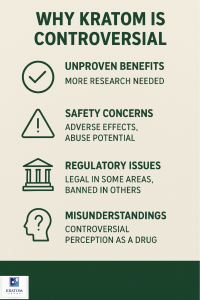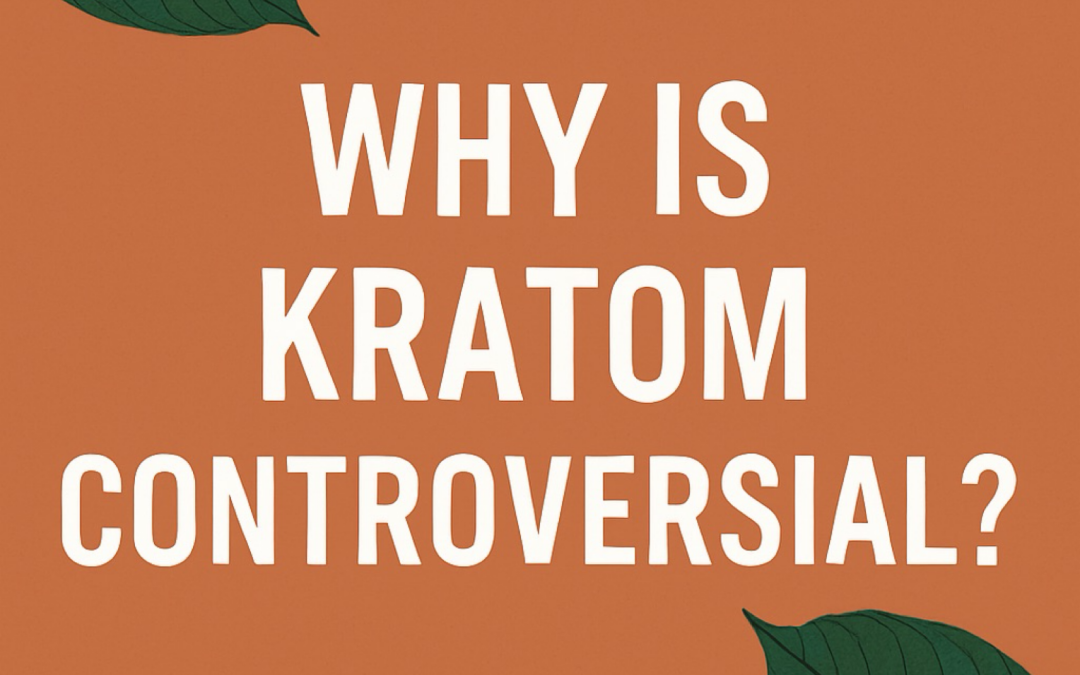🌿 A Balanced Look at Benefits, Safety, and Misunderstandings
Kratom (Mitragyna speciosa) is a tropical tree native to Southeast Asia, where its leaves have been used for centuries to support energy, relieve discomfort, and promote relaxation. In recent years, kratom has gained popularity in the United States as a natural wellness alternative. But with this rise in interest has also come controversy. Some people praise kratom as a safe and effective botanical, while others raise concerns about its potential misuse.
So why is kratom controversial — and what does the evidence really say? Let’s explore the history, benefits, and scientific facts behind this natural plant.
🔑 Key Points
-
Kratom has been used safely for centuries in Southeast Asia.
-
It is not an opiate, though it interacts with some of the same receptors.
-
Kratom does not suppress breathing the way opioids do.
-
Benefits include energy, relaxation, mood support, and pain relief.
-
Controversy stems from misinformation, misuse, and regulatory uncertainty.
📜 A Long History of Safe Use
For hundreds of years, kratom leaves have been chewed or brewed as tea by farmers and laborers in Thailand, Malaysia, and Indonesia. Traditionally, small doses were taken to fight fatigue and increase endurance during long hours of work. Larger doses were used for relaxation in the evenings or to ease aches and soreness. This cultural history shows kratom as a plant-based aid used in daily life, not as a substance of abuse.
🌱 Benefits of Kratom
Modern kratom users often report a wide variety of benefits:
-
Energy & Focus: In small amounts, kratom can provide a clean boost of energy without jitters.
-
Mood Support: Many find kratom helps with relaxation, positivity, and emotional balance.
-
Pain Relief: At higher doses, kratom may soothe discomfort and support better rest.
-
Muscle Relaxation: Red vein kratom in particular is valued for calming sore or tense muscles.
While research is still ongoing, surveys and studies show that kratom is widely used as a safer alternative to opioids or as a natural wellness option.
🚫 Why Kratom Is Not an Opiate
One of the biggest misunderstandings about kratom is that it is often called an “opiate.” This is not true.
-
Opiates are substances directly derived from the opium poppy, like morphine or heroin.
-
Kratom, however, is a plant in the coffee family. Its primary alkaloids, mitragynine and 7-hydroxymitragynine, do interact with opioid receptors — but in a very different way.
Unlike opiates, kratom does not cause the same level of respiratory depression (slowed or stopped breathing), which is the most dangerous side effect of opioid overdose. This is one of the key differences that makes kratom much safer.
😮💨 Kratom and Breathing Safety
A major reason for kratom’s controversy is fear that it carries the same risks as opioids. However, scientific studies have shown that kratom does not suppress the respiratory system like opioids do. In fact, research in animals and human reports confirm that kratom’s alkaloids lack the powerful respiratory depression effect of drugs such as oxycodone, fentanyl, or heroin.
This difference is critical: while opioids can be fatal in high doses due to slowed breathing, kratom’s natural alkaloids do not have the same dangerous impact.
⚖️ Why Is Kratom Controversial?
 If kratom has so many benefits and a strong safety record, why is it controversial? A few reasons stand out:
If kratom has so many benefits and a strong safety record, why is it controversial? A few reasons stand out:
-
Regulatory Uncertainty: Some U.S. states restrict kratom, while others protect it through the Kratom Consumer Protection Act (KCPA). Federal regulation is still unclear.
-
Misuse & Misinformation: A small number of cases involving adulterated or combined products (kratom mixed with other substances) have led to alarmist headlines. Pure kratom, however, has not been shown to cause fatal overdoses.
-
Confusion with Opiates: Because kratom interacts with opioid receptors, it is often incorrectly lumped in with dangerous opioids, despite critical differences in chemistry and effects.
🗣️ What Real Users Say
“Kratom gave me my life back. I use it for chronic back pain, and it lets me function without prescription opioids.” — Sarah K.
“As a coffee alternative, green vein kratom keeps me alert and focused during work without the jitters.” — Jason M.
“Red Bali helps me relax at night and manage soreness from the gym. I sleep better and wake up refreshed.” — Lindsay R.
❓ FAQ
Q: Is kratom an opioid?
A: No. Kratom is part of the coffee family, not the opium poppy family.
Q: Can kratom stop your breathing?
A: No. Unlike opioids, kratom does not suppress breathing in normal use.
Q: Why is kratom banned in some states?
A: Mostly due to misinformation, lack of education, and regulatory caution.
Q: What is the Kratom Consumer Protection Act?
A: A law in some states that ensures kratom is sold safely and responsibly.
Q: Is kratom addictive?
A: Like coffee, regular use can lead to dependence for some, but it is not comparable to opioid addiction.
🌿 Final Thoughts
Kratom is controversial because it is misunderstood. While some confuse it with opioids, the truth is that kratom is a natural plant in the coffee family with a long record of safe, traditional use. It offers unique benefits for energy, mood, and relief — and unlike opioids, it does not suppress breathing.
As more research emerges and regulations improve, kratom is becoming recognized not as a dangerous substance, but as a valuable botanical that deserves a fair and balanced place in the wellness world.


